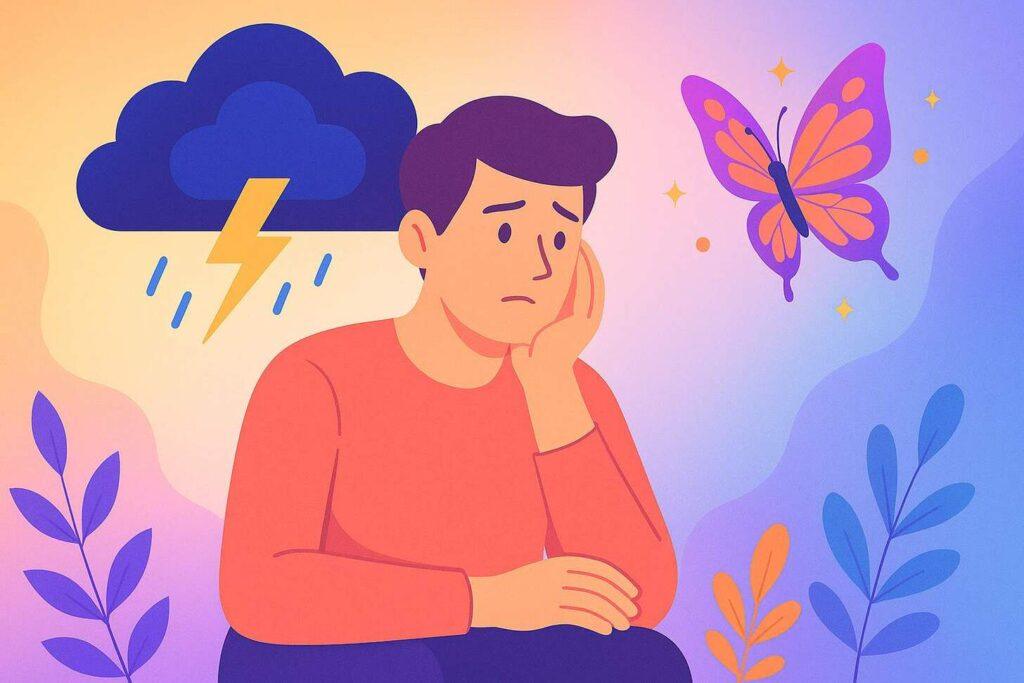Have you ever wondered how a single conversation or choice could reshape your entire future? That’s the butterfly effect mental model in action. Born from chaos theory, this idea shows how tiny actions—like a butterfly flapping its wings—can trigger massive, unexpected changes in complex systems.
Scientists first discovered this concept through weather prediction. Meteorologist Edward Lorenz found that rounding a number like 0.506127 to 0.506 in his model completely altered long-term forecasts.
Life works similarly: a chance meeting at a coffee shop might lead to a career breakthrough, while skipping a routine eraserrands could dodge a life-altering accident.
This isn’t about controlling outcomes. It’s about recognizing how small changes ripple through interconnected systems. From business strategies to personal relationships, every decision carries hidden weight. Even what seems insignificant today might bloom into something extraordinary tomorrow.
Key Takeaways
- Small choices can create huge, unpredictable results over time
- Originated from chaos theory in weather science
- The butterfly effect mental model applies to careers, relationships, and global events
- Focuses on awareness, not control, of outcomes
- Every action matters in tightly connected systems
By understanding the butterfly effect mental model, we learn to respect the power of our daily decisions—while embracing the beautiful uncertainty of life’s domino effects.
Introduction to the Butterfly Effect
What if a tiny change, a butterfly effect, today could change everything tomorrow? This question lies at the heart of a powerful idea from science. Imagine a world where a single social media post reshapes public opinion, or a driver’s split-second choice alters traffic patterns for thousands.
These aren’t random events—they’re examples of how small shifts create big waves, a part of the complex web that influences our mental health and relationships.
Defining the Concept
The core idea isn’t about insects or weather. It’s about connections we often miss. Think of the butterfly effect as an example of dropping a pebble in a pond—the ripples reach farther than you’d expect, just like how the flap of a butterfly’s wings can lead to significant results.
In our world, actions work the same way. A manager’s casual comment might boost team morale for months. A delayed flight could lead to meeting a future business partner.
The Impact of Small Changes in Complex Systems
Why do seemingly minor events matter so much? Our world operates like a giant web. Stock markets, ecosystems, and even friendships depend on countless invisible links. When one thread vibrates, others respond—sometimes in surprising ways.
Consider how a meme spreads online. One share leads to ten, then a million. The original creator never planned for global reach, but the system’s complexity made it possible. This unpredictability keeps scientists humble and leaders alert—because controlling outcomes becomes impossible in tangled networks.
Origins: Edward Lorenz and Chaos Theory

How could typing six decimal places instead of three rewrite scientific history? Meet Edward Lorenz—a math-loving meteorologist who accidentally changed how we see the world. While modeling weather patterns in 1961, he discovered that nature’s rules aren’t as straightforward as we thought.
Lorenz’s Discovery Through Weather Modeling
Picture this: Lorenz typed “0.506” instead of “0.506127” into his clunky computer. The result? A weather forecast that looked nothing like his original prediction.
That tiny difference—just 0.000127—proved something revolutionary. Systems like climate don’t follow neat paths. They’re more like domino rallies where one nudge changes everything.
This “sensitive dependence on initial conditions” became the heart of chaos theory. Lorenz realized we’ll never track every raindrop or breeze perfectly. As he joked, “Does the flap of a butterfly’s wings in Brazil set off a tornado in Texas?” The answer wasn’t literal—but it reshaped science forever.
How Chaos Theory Transformed Predictive Models
Before Lorenz, scientists believed better data meant better predictions. His work flipped that idea. In 1963, his groundbreaking paper showed why long-term weather forecasts will always have limits.
Tiny measurement errors grow exponentially—like forgetting one ingredient in a recipe and ending up with a cake that’s charcoal.
Today, chaos theory helps us understand stock markets, heart rhythms, and even traffic jams. It taught us humility: some patterns are predictable, but perfection? That’s just a myth.
Thanks to a curious meteorologist, we now see the world as a web of connected possibilities—not a clockwork machine.
Exploring The Butterfly Effect Mental Model
That morning coffee run or offhand comment might hold more power than you think. Our world thrives on connections where tiny sparks ignite big transformations. Let’s unpack how these invisible threads weave through our lives.
Why Starting Points Shape Outcomes
Imagine baking cookies with slightly chilled butter instead of room-temperature. The result? Crumbly disasters instead of chewy perfection. This principle applies everywhere—initial conditions set the stage for what follows.
| Scenario | Small Shift | Long-Term Impact |
|---|---|---|
| Forest Ecosystem | Removing one predator species | Overpopulation of prey, vegetation loss |
| Career Growth | Attending a networking event | New job offer 3 years later |
| Traffic Flow | One driver braking suddenly | 40-minute highway backup |
When Little Things Change Everything
Ray Bradbury’s famous tale shows a crushed insect altering human evolution. While fictional, it mirrors real patterns. A missed bus leads to meeting a future spouse. A single therapy session starts healing years of anxiety.
Scientists see this in action daily:
- Weather models diverging from minor data tweaks
- One mutated gene driving species adaptation
- Social media posts sparking global movements
These patterns teach us to value small acts. Holding a door open might lift someone’s mood, creating ripple effects we’ll never see. Life’s beauty lies in these unseen connections—where today’s tiny step becomes tomorrow’s leap.
Real Applications of the Butterfly Effect

Imagine being patient zero in a crowded city—your single sneeze could rewrite a community’s health story. From disease control to flight schedules, small triggers create waves we feel for weeks. Let’s explore how this plays out in critical areas affecting millions.
| Situation | Initial Event | Outcome |
|---|---|---|
| New York Communities (2019) | One measles case | 600+ infections |
| National Air Travel (2002) | 30-minute delay at Chicago O’Hare | 70+ flight disruptions |
Influence in Public Health and Epidemic Spread
A 2019 CDC report revealed something startling. One unvaccinated traveler in New York started a measles chain reaction. Through schools and community centers, it spread to 600 people. This shows how health systems depend on every individual’s choices.
Diseases thrive in connected networks. A handshake here, a subway ride there—soon, entire neighborhoods face outbreaks. Health teams now map social links to predict where small events might blow up.
Butterfly Effect Mental Model in Aviation and Transportation
One foggy morning in Chicago changed air travel nationwide. A 2002 study found a single delayed plane created 70+ missed connections. Why? Planes reuse crews and gates—like dominos knocking into each other.
Transport systems are clocks with a million gears. A late baggage truck in Dallas might delay a Tokyo-bound flight. Managers now build buffer times, knowing tiny hiccups can snowball.
These cases teach us: In our linked world, your choices matter more than you think. Whether masking up or arriving early, small acts shape big events.
Business and Economic Impacts of Small Changes

What does a 6.8 magnitude earthquake have to do with empty car lots in Texas? In 2011, that exact scenario unfolded when a tremor in Japan halted production at a single Toyota supplier.
Within weeks, dealerships worldwide faced shortages—proving how modern commerce dances on a spiderweb of connections that affect people’s mental health and well-being.
Toyota’s Supply Chain Earthquake
The automaker lost 40% of global output from one disrupted factory. Why? Modern manufacturing relies on just-in-time delivery—a system where parts arrive moments before assembly.
Like dominos, the missing component stopped entire production lines. Mechanics in Detroit waited for brake parts. Sales teams in Berlin revised delivery dates. All from a supplier 6,000 miles away.
When Tweets Move Markets
Remember when Elon Musk tweeted about taking Tesla private? Shares surged 11% in hours. Benoit Mandelbrot’s research explains this: traditional models ignore how real markets react to sparks.
Facebook’s choice to add a “Like” button? That tiny feature hooked billions—turning dorm-room code into a social empire.
| Event | Trigger | Result |
|---|---|---|
| 2008 Crisis | Subprime mortgage approvals | Global recession |
| Facebook News Feed | Algorithm tweak | 2B+ daily users |
| 2020 Oil Prices | Storage tank shortage | Negative $37/barrel |
Smart companies now build resilience into every process. They know a delayed shipment or social media post could rewrite their future. Your choices matter too—whether negotiating contracts or choosing suppliers. In our linked world, small steps create big waves.
The Butterfly Effect in Mental Health and Crisis Management

Could a single kind word prevent a crisis? Recent studies show how small acts in healthcare settings create waves we can’t always predict.
Emergency rooms saw youth mental health visits double in ten years—with suicide-related symptoms jumping fivefold. These numbers remind us: every interaction holds hidden power.
Healing Through Early Actions
Child psychologists found quick interventions during inpatient care often stop crises from growing. A comforting conversation or adjusted medication might steer someone toward recovery instead of relapse. Like planting seeds in fertile soil, early support gives better outcomes time to grow.
Roots of Resilience
Why do some people bounce back while others struggle? It starts with conditions we often overlook—stable homes, trusted friends, access to care. COVID-19 taught us this harshly: isolation fueled anxiety and depression globally. Yet clinics using community-based programs saw fewer repeat ER visits.
Leaders now build flexible systems that adapt to tiny changes. Training teachers to spot warning signs. Creating peer support networks.
These actions prove daily choices matter—in healthcare and beyond. After all, tomorrow’s wellbeing grows from today’s small steps.
Conclusion
The butterfly effect mental model reminds us that even the smallest decisions can echo across time and space. Whether it’s a casual comment, a supply chain hiccup, or a moment of compassion in a crisis, tiny triggers often shape massive outcomes.
In business, health, or personal life, recognizing this principle helps us act with more awareness—even when the results remain unseen. By respecting these ripple effects, we learn that no action is too small to matter, and no outcome is fully predictable.
That’s the quiet power of the butterfly effect.


